|
 Physarum bitectum Physarum bitectum
BiostatusPresent in region - Indigenous. Non endemic
Images (click to enlarge)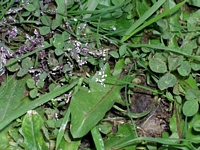
Owner: J.A. Cooper | 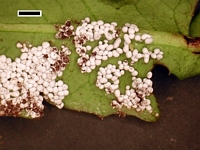
Caption: scale = 2mm
Owner: J.A. Cooper | 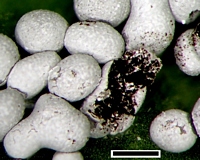
Caption: scale = 0.5mm.
Owner: J.A. Cooper | 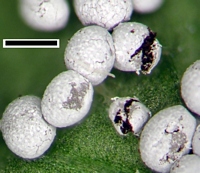
Caption: scale=0.5mm. Note two layers to peridium
Owner: J.A. Cooper | 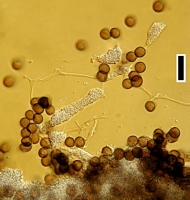
Caption: scale = 20um. Spores, capillitial threads and nodes. Part of peridium at bottom.
Owner: J.A. Cooper |
Article: Stephenson, S.L. (2003). Myxomycetes of New Zealand. Fungi of New Zealand. Ngā Harore o Aotearoa 3: xiv + 238 p. Hong Kong: Fungal Diversity Press.
Description: Fruiting body a sessile sporangium or sometimes plamodiocarpous, scattered to gregarious, slightly compressed, up to 6 mm long and 0.6–0.8 mm in diameter. Hypothallus inconspicuous. Peridium consisting of two layers, the outer layer free, calcareous (occasionally limeless towards the base), smooth to rugose, white to beige (or shining, purplish brown when limeless) on the outside and purple to white inside, deciduous above, persistent and sometimes recurved below, inner layer membranous, rugulose, colourless, grey or purplish, persistent, dehiscence irregular. Columella absent. Capillitium consisting of large, variously shaped, white lime nodes and hyaline, short connecting filaments. Spores black in mass, dark violaceous brown by transmitted light, coarsely and irregularly spiny, sometimes with paler, smoother areas, 10–13 µm in diameter. Plasmodium white.
Habitat: Dead leaves, twigs and other types of plant debris.
Distribution: Reported from widely scattered localities in Africa, Europe, North America, and South America (Martin & Alexopoulos 1969). Probably cosmopolitan (Ing 1999) but seemingly most common in temperate regions of the world. First reported from New Zealand by Mitchell (1992), based on a specimen collected in Auckland. Also known from Mid Canterbury.
Notes: The fruiting bodies of this species resemble those of Physarum bivalve but are usually more or less round in cross section, whereas those of the latter species are laterally compressed. Moreover, the pattern of dehiscence (irregular in P. bitectum and by means of a longitudinal fissure in P. bivalve) is different.
|